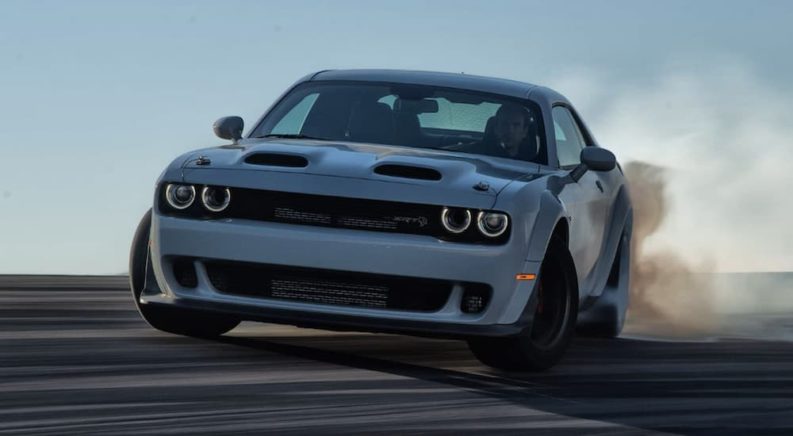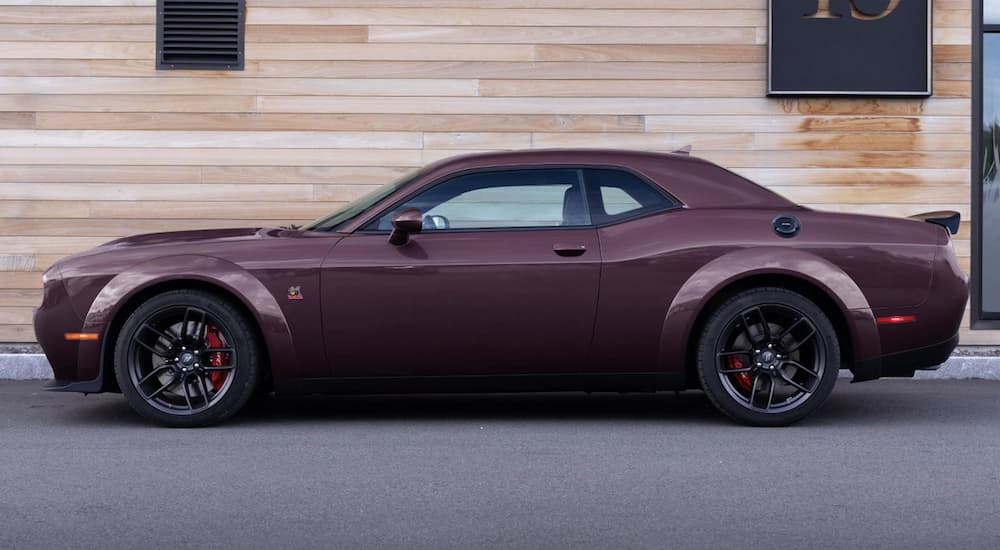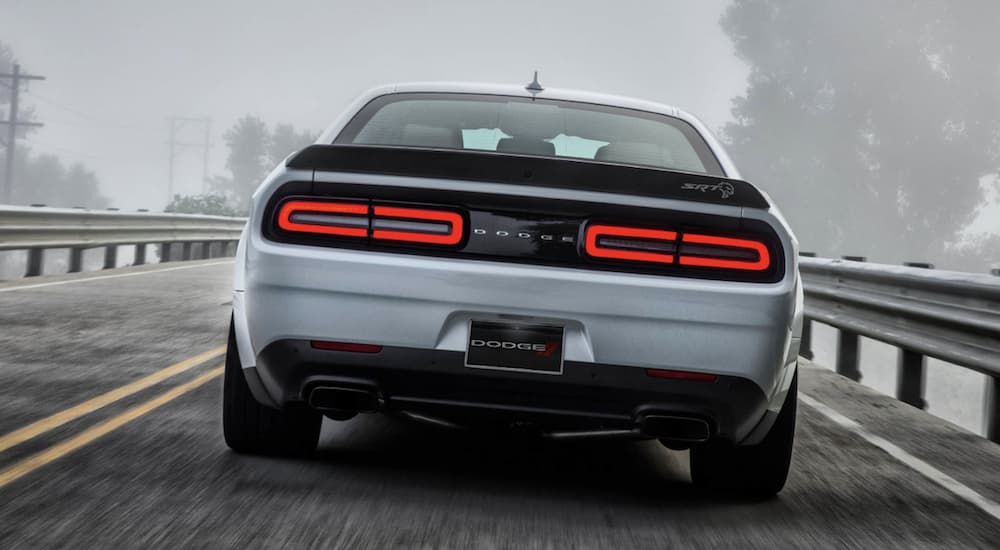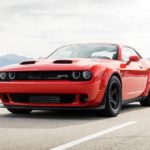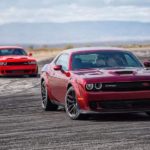As buyers rush to dealerships to buy the 2022 Dodge Challenger—while the getting is good, plans are brewing at Stellantis for electrifying the world’s remaining muscle cars. Could it lead to a bigger future market of muscle cars in an era of SUVs?
Despite so many buyers seeking larger vehicles with more room inside and a higher ride height, we know there is still a staunch and loyal following of muscle car advocates who absolutely love driving for the art of it. Nowhere to be except behind the wheel. Nowhere to go except where the road leads. Performance cars aren’t going anywhere except better—and that’s what electric is bringing to performance cars like the Dodge Challenger.
What Could an Electric Challenger Mean?
In a video from Stellantis—the owner of Dodge, Chrysler, Maserati, among others—targeting a global audience of investors, the company provides a sneak peek into the future. Electrification could be reshaping the entire company, including Dodge’s plans for its muscle car future. Dodge Brand CEO, Tim Kuniskis, stated, “Dodge will not sell electric cars. Dodge will sell American eMuscle.” Kuniskis went on to say that Dodge customers “buy an experience, not a technology.”
Though Kuniskis may be leaning into a holistic appeal for the overall brand, technology will most certainly be part of the plan, as muscle cars like the Challenger embrace electrification. Like so many other brands that have already gone electric, Dodge vehicles will benefit from inclusions of technology like over-the-air updates, configurable digital displays that zero in on performance data, and the capability to customize personal experiences with onboard tech smart enough to learn from interactions. We already see this type of tech being employed by Ford and GM for a more mainstream set of buyers; now, Dodge is jumping on the bandwagon to be part of the EV party—with a distinct “eMuscle” twist.
A young and diverse set of buyers makes up a high percentage of those who are attracted to what Dodge performance cars offer. Dodge’s messaging is clear: Millennials and adult Gen Zers are directing the flow of traffic toward electrification. Yet, a dedication to innovate is nothing new. As a brand, Dodge relies on pushing the envelope to the extreme. It’s a core attribute of any Dodge marketing campaign to deliver edgy messaging to match the edgy performance of vehicles like the Challenger, which go beyond the norm in terms of capability.
As a reference, one only needs to peruse the latest details about the Jailbreak package—a total custom-build package available for the Challenger and Charger SRT Hellcat Redeye models. Dodge is clearly willing to give drivers what they’re asking for. The next logical step, then, is to stop trying to squeeze more juice out of the HEMI V8s that litter the lineup, and instead embrace a platform of electrification. This will take the Challenger and Charger into territory where torque and horsepower reign supreme.
When Will the Challenger Go Electric?
Dodge has made the announcement that by 2024, the first muscle car will be released as a fully electric vehicle “to tear up the streets, not the planet,” says Kuniskis. Well, that and the fact that the performance envelope can be pushed into obscene ranges of power that we are only beginning to grip—as EVs are being released into the market. Ford and GM have their performance vehicles like the Mustang Mach E and the Hummer EV, both of which are extreme in the amount of horsepower, torque, and technology; they provide a new wave of driving never before seen. Other performance-related platforms like Porsche, Audi, and BMW are raising the game with EVs, and even Jeep has its own version of an EV, with its hybrid that can go into stealth mode for off-roading in virtual silence when running on an electric motor. While some may be surprised by Dodge’s announcement to go electric, it actually comes as a surprise that the brand has taken this long to make the jump into enhanced, modernized performance.
Promises for How the Plan Will Roll Out
As the vehicles are designed and built, Stellantis is aiming for a clear target: driving range and rapid charging. It’s not enough to have the power; Dodge muscle cars need to be practical, too. This makes sense, when considering the fact that the Challenger and Charger both have a usable back seat for passengers, as well as a large trunk, to make driving these speed demons far friendlier to owners with families.
Practicality is part of the Dodge brand, so it stands to reason that a driving range between 300-500 miles is a reasonable target for Stellantis EVs. Being able to charge the battery at a quick 20 miles per minute would also be attractive to potential owners. Currently, Chevy has released data for the 2024 Silverado EV that shows rapid charging will mean adding 100 miles of range in ten minutes. That puts charging speed for Stellantis EVs at twice what Chevy will have, which plays into Dodge branding for speed.
Expectations for battery production will include a pair of options that will kick off the lineups within the Stellantis family of brands. One of these will be produced specifically for performance vehicles, which will be fitted with energy-dense battery packs for 2024. Stellantis believes the resulting increased production of batteries should eventually lead to prices of production to drop, which should then lead to prices of EVs to drop, too.
But the world is just on the cusp of embracing EVs as a greener option for travel. No one can accurately predict the nature of the market until more EVs are being purchased for the masses. With that said, following the first wave of EVs to undergo production, a second goal for 2026 is to utilize solid-state batteries, which will be lighter and provide more driving range.
Other goals for the roll-out of EVs include the intention for Stellantis to increase the percentage of buyers purchasing EVs. For its European market, only about 15% of buyers are currently purchasing EVs, a rate Stellantis hopes will be as high as 70% by 2030. In the US, goals are less lofty, with only 4% of buyers currently purchasing EVs. By 2030, the expectation is for US buyers to reach for an increase to 40%.
Once production ramps up globally, five separate facilities will be dedicated to EV manufacturing, each one slated to build as many as two million vehicles annually. As it stands, the immediate future will include more plug-in hybrids across the Stellantis brands, though there is no mention of which brands will take this smaller step before taking the big leap into fully electric models.
New Branding for Dodge
With new fuel for performance, it seems a new identity was deemed appropriate. A new logo was revealed for the Dodge EV performance car, a throwback to a logo used in the ’60s and ’70s—when muscle cars were in their prime. Dodge is apparently reviving that old spirit as it dons a new electric platform. We still don’t know exactly what vehicle is hiding behind the smoke and mirrors in the video footage where the logo was revealed, as the lighting is intentionally dim.
And yet, with so much joy derived from cars like the Challenger, Dodge would be remiss in leaving the Challenger behind. With the future uncertain for the fabled muscle car, perhaps this is a good time to grab one for yourself—before they’re gone.

